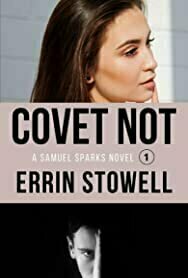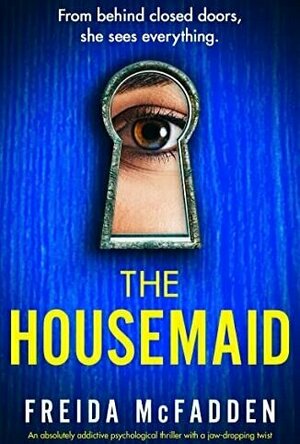
Ultimate Jungle Simulator
Games and Education
App
Dash into your newest adventure as a powerful Gorilla, crafty Lemur, or a deadly Tiger! Choose from...

Ultimate Forest Simulator
Games and Education
App
Dash into your newest adventure as a ferocious Bear, speedy Rabbit, or a deadly Cougar! Choose from...

Piikki: Receipt Scanner
Finance and Productivity
App
Piikki is an amazing receipt scanner app for your iPhone & iPad. +++ Scan your receipts using the...

This War of Mine: The Board Game
Tabletop Game
This War Of Mine: The Board Game is the tabletop adaptation of the award-winning video game that...
If this sounds like a synopsis for a John Grisham novel, you wouldn't be far off because Stowell has the potential to be the next one. This is only the first novel I've read by Stowell, but the one thing I noticed mostly in this story was the amount of inconsistencies and amateur writing mistakes; with better editing and consistency, his books could very well hit mainstream.
Also, Covet Not had so many chapters, so much so that scenes were chopped in half and made into entirely new chapters. The book ended up having 48 chapters within 158 pages. This amount could have easily been shortened and helped with the flow of the story if Stowell had just continued onwards with scenes rather then cutting them short or just skipping parts completely.
The novel starts with a man called Skinny who is enjoying his growing infamy on the dark web (he records himself murdering women then uploads it for his audience to enjoy). Here is how Stowell describes Skinny's thought process:
" Skinny took a black ski mask from the duffel bag and put it on before carrying the bag into the camera's frame and placing it near the woman. He began unpacking other items from the bag. It was slow work, deliberately slow for the camera. Skinny intended to have a before and after view for each tool. It was important to show the proper use of tools. The viewers always appreciated that. "
When we switch over to Sparks, we find him after a long day of work, speaking with a journalist named Gina, his fiancee, who is telling him one of her co-workers stole her story, but no one has heard from her in two days. Yet, they both agree that she's probably holed up with one of the producers, and instead, get into a small argument about Sparks never supporting Gina - - - a constant habit of arguing is almost every interaction between the two throughout the entire novel.
Soon after, Sparks introduces us to his uncle Jimmy, who is being housed at a retirement home: " The old man was seated in a wheelchair; his left leg had been amputated just below the knee a few years before, the result of allowing an ingrown toenail to fester to gangrene. Jimmy's barrel chest and solid upper body contrasted with his wasting legs. "
As Sparks continues to visit his uncle in the retirement home, he keeps running into a cute nurse named Darlene, who quickly sets her sights on him. She goes so far out of her way to get Sparks and Gina to separate that she sends him nude photos of herself from a burner phone. Fortunately, Sparks has bigger fish to fry when he hears over his car radio that Gina's co-worker was now being treated as a missing person case, causing Sparks to quickly jump to the conclusion that Gina possibly was responsible for it.
However, Stowell throws in an expected curveball by making our villain, Skinny, work at the retirement home. When he comes in to take care of a patient while Sparks is present, it's too easy to guess that this patient was going to end up dead soon. Sparks, expectedly, has a bad feeling about this male nurse, but dismisses it and believes that the patient died by natural causes. Life goes on.
Stowell's novel, with a great plot, was just too focused on ending the story, that after page 50, it seemed as if Stowell didn't care what happened to these characters, just as long as he finished the book. At one point, readers are told that Sparks doesn't drink alcohol, but it's never explained why he doesn't which would have given a bite of character development; another scene, Sparks finds a phone, but doesn't want to give it to police, instead he states that he has a 'friend' in the police department who can go through it as a favor, but this 'friend' is completely forgotten, as if Sparks never mentioned him, and the former is left dumbfounded as to how to get into the phone.
There's a story here and characters that could be more well-rounded, but I honestly found myself not caring the least bit about any of the characters' well-being, especially Sparks - - - someone who comes off as inept, someone who has to be told what to do in order for anything to get done - - - he's like a lost child running blindly throughout the book. The story needs to be longer with more emphasis given to mundane scenes that will allow readers to chew on a piece of Sparks' daily life because, by the end of the book, we needed a full picture of every major character, not a Jackson Pollock.
Hazel (1853 KP) rated The Music Shop in Books
Aug 22, 2017
From the author of The Unlikely Pilgrimage of Harold Fry comes a unique and beautiful story about music and learning how to listen. The Music Shop by Rachel Joyce takes readers on a journey through the developing music world of the late 1980s when CDs are beginning to wipe out all other means of recording music – a complete disaster for someone like Frank, the owner of the music shop, who only sells vinyl.
The book begins in 1988 in a crumbling down street where shopkeepers are barely making enough money to survive. Frank’s shop is one of the few remaining and, despite everything against him, is determined to keep going. Not only does he sell vinyl records, Frank has an empathetic gift allowing him to sense exactly what a customer needs to listen to, even though they may not realise it themselves. However, one day, Frank’s world is turned upside down by the arrival of a young German woman, Ilse Brauchmann, who faints on his doorstep.
Ilse intrigues all of the shopkeepers on Unity Street, particularly Frank’s teenaged assistant, Kit. Although Frank tries to deny it, Ilse also fascinates him to the point that he is rarely thinking of anything else. But what concerns him most is that he cannot pinpoint what piece of music she ought to listen to. When questioned, Ilse admits she knows nothing about music and begs Frank to give her lessons. These lessons have nothing to do with instruments – Frank is the least qualified to teach such a thing – but about how to listen to music. How to hear the pauses in classical pieces; understand the meaning behind Beethoven’s sonatas; feel the passion behind punk music; learn to love a number of composers for the things many people miss.
The longer Frank spends around Ilse, the more he begins to fall in love. However, love is something Frank denies himself ever since the death of his mother fifteen years previously. Written in italics are flashback chapters explaining how Frank’s love of music came about, his relationship with his mother, and how he ended up as a dead-end vinyl seller. Due to his fear of intimate relationships, Frank keeps pushing Ilse away until, one day, he realises how much he needs her. But, he may have left it too late.
The Music Shop is split into four sections, or sides (a reference to vinyl records). Side A introduces the characters and settings during a wintery January when Frank is beginning to struggle with the competition caused by the recently opened Woolworths on the nearby high street. Sides B and C focus on the development of Frank and Ilse’s friendship, the secrets they hide from each other and the foreboding sense of disaster hanging over the one-of-a-kind music shop.
As Frank begins to realise how much Ilse means to him, the sudden appearance of side D will break readers’ hearts. Whilst sides A, B and C take place in 1988, side D jumps forward 21 years to 2009. It appears Frank and Ilse never got the relationship they deserved. Two unhappy decades have been and gone, demolishing any resemblance of the way life used to be. However, because there is a side D, readers can only hope it will result in a happy ending.
The Music Shop is a love story between two quiet, modest characters whose past and present circumstances get in the way of a peaceful future. However, it is not only a piece of romantic fiction. Rachel Joyce writes a message in story format about second chances and being brave. Learning to listen does not only apply to music, it applies to hearing what other people are saying and what they are not; most importantly, the book urges people to listen to themselves.
The research undertaken for this novel is phenomenal. For starters, it is set almost thirty years ago when vinyl was only beginning to go out of fashion. The quality of music and the access people had to it was extremely different to the simplicity of today where it is possible to download everything at the press of a button. The breadth of music genre is as wide as possible. Every type of music is covered from Handel’s Messiah to Aretha Franklin and The Sex Pistols. To be able to discuss such a range without falling into stereotypes is a feat worthy of congratulating.
The Music Shop far surpasses anything Rachel Joyce has written so far. The story is fragile in a beautiful way, its delicacy causing the reader to treat it with care, rather than rush through it like some mundane piece of fiction. It will interest a whole host of readers: male and female, music lovers and those with a preference for silence. Whoever you are, be prepared to take something away from this distinctive, outstanding novel.
Hazel (1853 KP) rated The Music Shop in Books
Dec 7, 2018
From the author of <i>The Unlikely Pilgrimage of Harold Fry </i>comes a unique and beautiful story about music and learning how to listen. <i>The Music Shop</i> by Rachel Joyce takes readers on a journey through the developing music world of the late 1980s when CDs are beginning to wipe out all other means of recording music – a complete disaster for someone like Frank, the owner of the music shop, who only sells vinyl.
The book begins in 1988 in a crumbling down street where shopkeepers are barely making enough money to survive. Frank’s shop is one of the few remaining and, despite everything against him, is determined to keep going. Not only does he sell vinyl records, Frank has an empathetic gift allowing him to sense exactly what a customer needs to listen to, even though they may not realise it themselves. However, one day, Frank’s world is turned upside down by the arrival of a young German woman, Ilse Brauchmann, who faints on his doorstep.
Ilse intrigues all of the shopkeepers on Unity Street, particularly Frank’s teenaged assistant, Kit. Although Frank tries to deny it, Ilse also fascinates him to the point that he is rarely thinking of anything else. But what concerns him most is that he cannot pinpoint what piece of music she ought to listen to. When questioned, Ilse admits she knows nothing about music and begs Frank to give her lessons. These lessons have nothing to do with instruments – Frank is the least qualified to teach such a thing – but about how to listen to music. How to hear the pauses in classical pieces; understand the meaning behind Beethoven’s sonatas; feel the passion behind punk music; learn to love a number of composers for the things many people miss.
The longer Frank spends around Ilse, the more he begins to fall in love. However, love is something Frank denies himself ever since the death of his mother fifteen years previously. Written in italics are flashback chapters explaining how Frank’s love of music came about, his relationship with his mother, and how he ended up as a dead-end vinyl seller. Due to his fear of intimate relationships, Frank keeps pushing Ilse away until, one day, he realises how much he needs her. But, he may have left it too late.
<i>The Music Shop</i> is split into four sections, or sides (a reference to vinyl records). Side A introduces the characters and settings during a wintery January when Frank is beginning to struggle with the competition caused by the recently opened Woolworths on the nearby high street. Sides B and C focus on the development of Frank and Ilse’s friendship, the secrets they hide from each other and the foreboding sense of disaster hanging over the one-of-a-kind music shop.
As Frank begins to realise how much Ilse means to him, the sudden appearance of side D will break readers’ hearts. Whilst sides A, B and C take place in 1988, side D jumps forward 21 years to 2009. It appears Frank and Ilse never got the relationship they deserved. Two unhappy decades have been and gone, demolishing any resemblance of the way life used to be. However, because there is a side D, readers can only hope it will result in a happy ending.
<i>The Music Shop</i> is a love story between two quiet, modest characters whose past and present circumstances get in the way of a peaceful future. However, it is not only a piece of romantic fiction. Rachel Joyce writes a message in story format about second chances and being brave. Learning to listen does not only apply to music, it applies to hearing what other people are saying and what they are not; most importantly, the book urges people to listen to themselves.
The research undertaken for this novel is phenomenal. For starters, it is set almost thirty years ago when vinyl was only beginning to go out of fashion. The quality of music and the access people had to it was extremely different to the simplicity of today where it is possible to download everything at the press of a button. The breadth of music genre is as wide as possible. Every type of music is covered from Handel’s <i>Messiah</i> to Aretha Franklin and The Sex Pistols. To be able to discuss such a range without falling into stereotypes is a feat worthy of congratulating.
<i>The Music Shop</i> far surpasses anything Rachel Joyce has written so far. The story is fragile in a beautiful way, its delicacy causing the reader to treat it with care, rather than rush through it like some mundane piece of fiction. It will interest a whole host of readers: male and female, music lovers and those with a preference for silence. Whoever you are, be prepared to take something away from this distinctive, outstanding novel.
Heather Cranmer (2721 KP) rated The Housemaid (The Housemaid #1) in Books
Nov 9, 2022
The Housemaid tells the story of Millie, a young woman down on her luck. With a prison background, getting a decent paying job has been hard to find. Millie's been living in her car for awhile after being let go from her most recent job. When a high paying job arises working for the Winchesters, Millie can hardly believe her luck when she's offered the job. All she has to do is keep the house clean, take care of the Winchesters' daughter Cecelia, and cook for them. It's not too bad considering how much she's being paid. Plus, she'll be able to finally sleep in a bed! However, things drastically take a turn for the worst on Millie's first day. Nina Winchester, the wife, is constantly berating Millie and leaving big messes for her. She's gaslighting Millie at every turn. Is there a method to Nina's madness or is Nina really out to get Millie?
I loved the plot of The Housemaid. I was definitely scratching my head trying to figure out what was going on at first. While I have read similar stories to this one, Freida McFadden adds varying elements to keep her story line original. There were plenty of twists and turns throughout. In fact, one twist happens within the first few chapters. Nothing is as it seems when it comes to the story line of this novel. I was sucked into the world McFadden had created. I felt like I was a character hiding in the shadows watching all the drama unfold. While there is a small cliffhanger, I feel like The Housemaid is a book that can be read as a standalone despite it being part of a series. I say this because all my questions and wonderings I had throughout reading The Housemaid were tied up nicely by the end of the book. (Although I would have liked to know a bit more about how Andrew Winchester, the husband, had amassed such a large fortune.)
Every single character main and secondary character in The Housemaid was well written. It was actually quite easy to picture each character in my mind. Each character's personality shown through with each page. I never knew what to expect with Nina. I kept trying to figure out why she was one way while interviewing Millie yet a whole different person from the very first day Millie started her job. I couldn't figure out why she kept gaslighting Millie and why she would hire her only to ridicule and belittle her at every given opportunity. I did like reading about Nina though and to finally get her perspective on why she was the way she was to Millie. Andrew seemed like a nice guy. He was always wanting to protect Millie from Nina's craziness, and I did keep finding myself wanting Andrew and Millie to become a couple as there was so much chemistry between them. I also thought Nina didn't deserve Andrew with how mean she was. Millie seemed like a sweet young woman that had been handed some bad cards throughout her life. I was wishing nothing but the best for Millie throughout the book. It was obvious that she was trying to get her life on track after all the bad she had endured. Enzo, the gardener, was the wild card. I never knew if I should trust him or not. While he seemed oblivious to everything around him, I was always left wondering if he knew more than he let on. One character I would have liked to know more about was Cecelia. She came across as a bit of a brat, and it becomes obvious why she would act that way, but I would have liked to know more about her life growing up in the Winchester residence such as what she would go through while she was away and what not. Saying all that about the characters, I will say that no one in this book is quite as they seem. What you see is not what you get with the people in The Housemaid.
Trigger warnings for The Housemaid include gaslighting, blackmail, profanity, torture, violence, murder, and captivity.
Overall, The Housemaid is a solid story that will leave you guessing which each page read. You won't know which character to trust or what is real. It will be all too easy to stay up late into the night to finish this book because it's just that good! I would definitely recommend The Housemaid by Freida McFadden to those aged 18+ who love being fully immersed in whatever they are reading. This book will suck you right into its pages from the get go. It'll also leave you with a distrust of attic rooms at the top of stairs!
Phillip McSween (751 KP) rated Gran Torino (2009) in Movies
Mar 25, 2018
Acting: 8
Clint Eastwood comes out of the gates swinging in playing racist Walt Kowalski. I thought it was a daring role seeing as, even though the character had a strong prejudices, you were still supposed to somehow like and respect him. Clint walks that line finely and pulls the role off with that smooth ease I've seen in a number of his previous roles.
Special love to a strong supporting role from Chee Thao who plays the angry Grandma of the Hmong family. She hates Clint as much as he hates her and their chemistry makes for some hilarious scenes. She captures the role perfectly.
Beginning: 1
Characters: 10
Gran Torino features a rich array of characters with meaning and depth. Walt is a man set in his ways after the war hardened him, but you find his walls slowly tearing down as the movie progresses. He reluctantly lets in the people that he wouldn't normally and finds himself becoming closer to them than his own family. While his heart may have changed, I appreciated the fact that his mouth didn't. Walt, with his brutal honesty, always spoke what was on his mind at all times which was funny and refreshing at the same time.
Thao (Bee Vang) has his own internal struggle as he deals with getting his education while trying to take care of his family and still fit in with the men in his family. He wants to be different than his thug cousins but he's too much of a softy to stand up for himself. Thao and Walt end up on a collision course towards each other surrounded by a number of characters that have their own stories worth paying attention to.
Cinematography/Visuals: 10
A lot of scenes stuck out in my head when considering Gran Torino. From family dinners to one-off scenes with Walt and Thao, the film provides believable insight into Walt becoming closer to his "enemies" than his own family. The dinners were shot in a claustrophobic type of way. Thao's house was littered with people and you find a surrounded Walt trying to navigate his way through while steering clear of being social. The film as a whole was shot in a dark style indicative of looming danger. It's unnerving in a way, but effective at the same time.
Conflict: 10
Genre: 7
Memorability: 10
The hard dramatic shift in the film is like a gut punch, both jarring and unexpected. I appreciate when a film can change tones and still be effective. I also appreciate when films show racism from both sides of the fence. There's a refreshing sense of realism you get with Gran Torino that may be sacrificed in other films for the sake of getting a point across. In Torino, no one is innocent. No one is exempt.
I can't even count the number of one-liners that Walt provides throughout the span of the movie. My personal favorite: "Good day, puss cake." I have often considered how hilarious it would be to randomly say that to someone. There's still time...
Pace: 6
Definitely could have been improvement in the pacing department. The beginning starts off extremely slow before moving at a shaky pace. It finally levels out at about the half hour mark, but the damage had already been done for me at this point.
Plot: 10
Solid storyline from beginning to end that is both intriguing and unique. We are provided with an insight into a different culture in an endearing way that makes you smile.
Resolution: 5
Overall: 77
Gran Torino is an original film that succeeds with gritty realism and strong characters. A few tweaks, particularly a stronger ending, would have put the movie into a higher tier for me. Still a solid watch.




